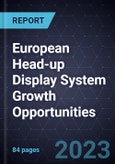A Gamified Driving Experience With Augmented and Virtual Reality is the Key to HUD Future Growth Potential
This study analyzes the European head-up display (HUD) market from 2022 to 2030. BMW was the first European original equipment manufacturer (OEM) to integrate HUD, a technological improvement over the head-down display (HDD) interface commonly used in the automotive industry. Over the years, HUDs have become a part of different types of vehicles in Europe. There are 3 types of HUD systems in the market. Combiner HUD projects data onto a screen on the dashboard; windscreen HUD projects data onto a small section on the windscreen; and AR-HUD projects augmented visuals onto the windscreen. As of 2022, combiner HUDs accounted for 14.4% penetration of the total HUD market. The most prevalent system in the HUD market in Europe is the windscreen HUD, as its newer generation can pack a larger field of view (FoV) and more volume in a compact size. The augmented-reality HUDs (AR-HUDs), which are the next-generation HUDs, have already hit the market in some premium brands, such as Audi and Mercedes Benz, and mass-market brands, such as Cupra, Hyundai, Kia, Skoda, and VW.
This study aims to examine, analyze, forecast, and give an overview of the HUD trends in Europe. It discusses the impact of these trends on the growth and deployment strategies of different OEMs and suppliers in the market. It analyzes various market aspects, including types of HUD systems and industry growth opportunities.
This report indicates that HUD penetration in Europe as of 2022 stood at 10.4% of sold vehicles. By 2030, HUDs are expected to penetrate roughly 36.8% of vehicles, with the market expanding at a CAGR of 21.0%.
The growth of the HUD market can be attributed to 4 main reasons:
- The demand for connected cars is growing.
- Consumer expectations with new-age technology in HMI are rising.
- OEMs need to differentiate their product from the competition.
- Increased adoption of electric vehicles (EVs) is driving OEMs to offer added features to distinguish their product from traditional ICE vehicles.
Table of Contents
Companies Mentioned (Partial List)
A selection of companies mentioned in this report includes, but is not limited to:
- Audi
- BMW Group
- Continental
- Cupra
- CY Vision
- Envisics
- Ford Motor Company
- Geely
- HARMAN
- Hyundai
- Kia
- Mercedes-Benz Group
- Nippon Seiki
- Panasonic
- Renault-Nissan-Mitsubishi Alliance
- Skoda
- Stellantis
- Toyota Motor Corporation
- Volkswagen Group








